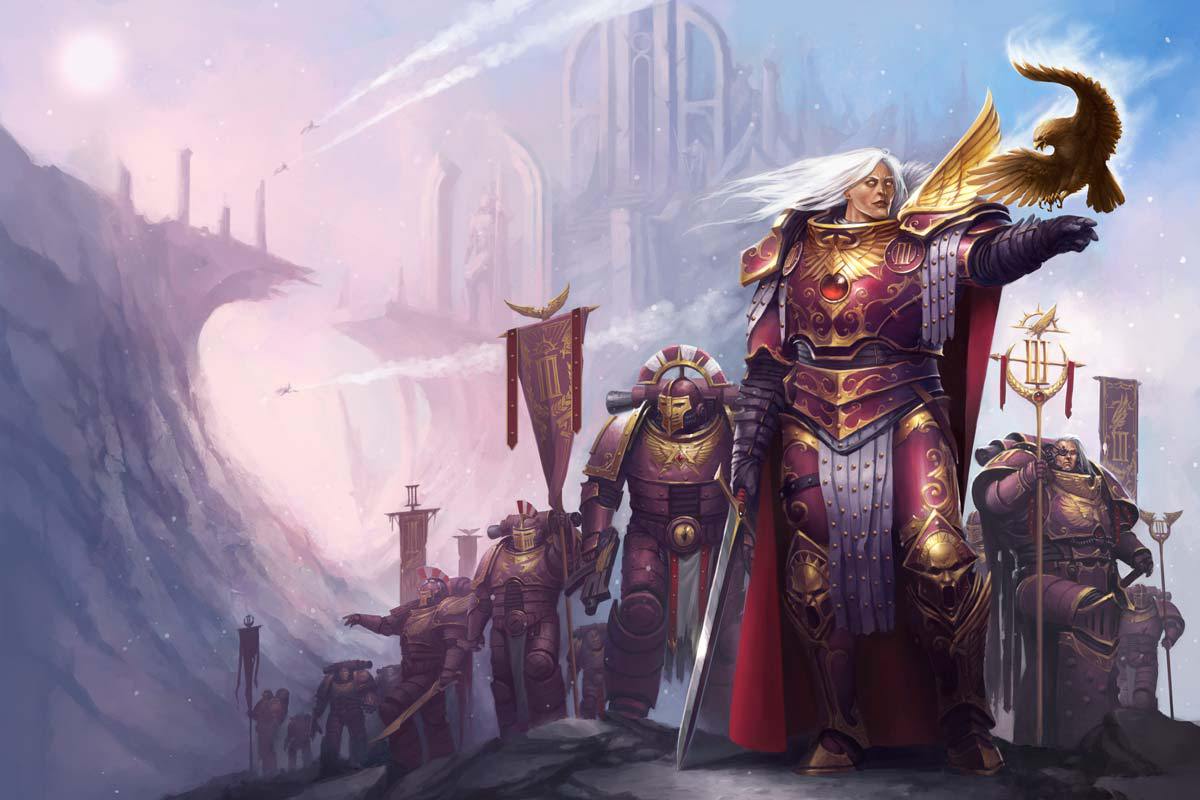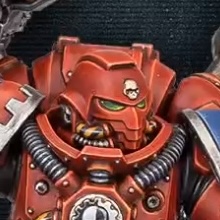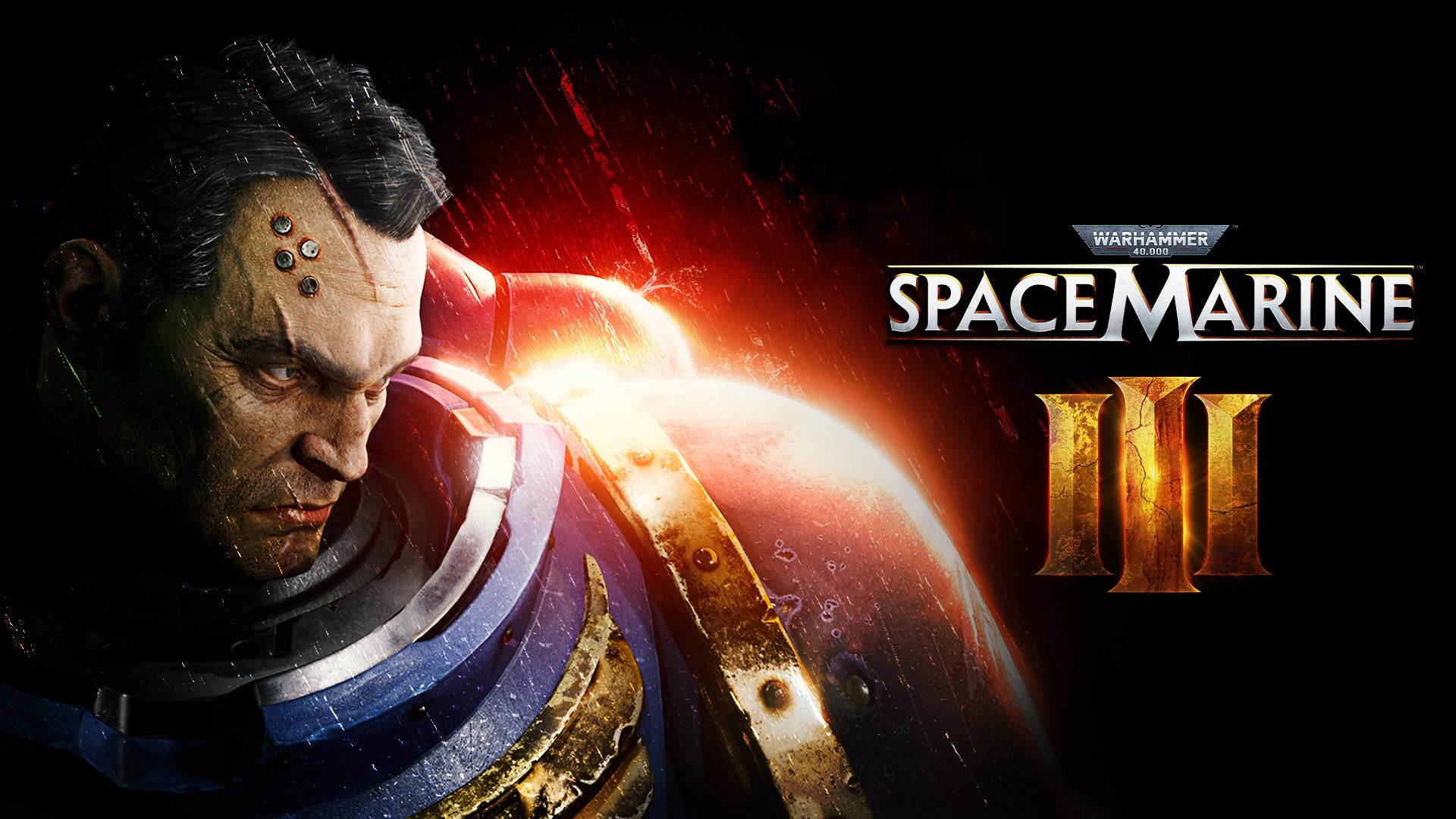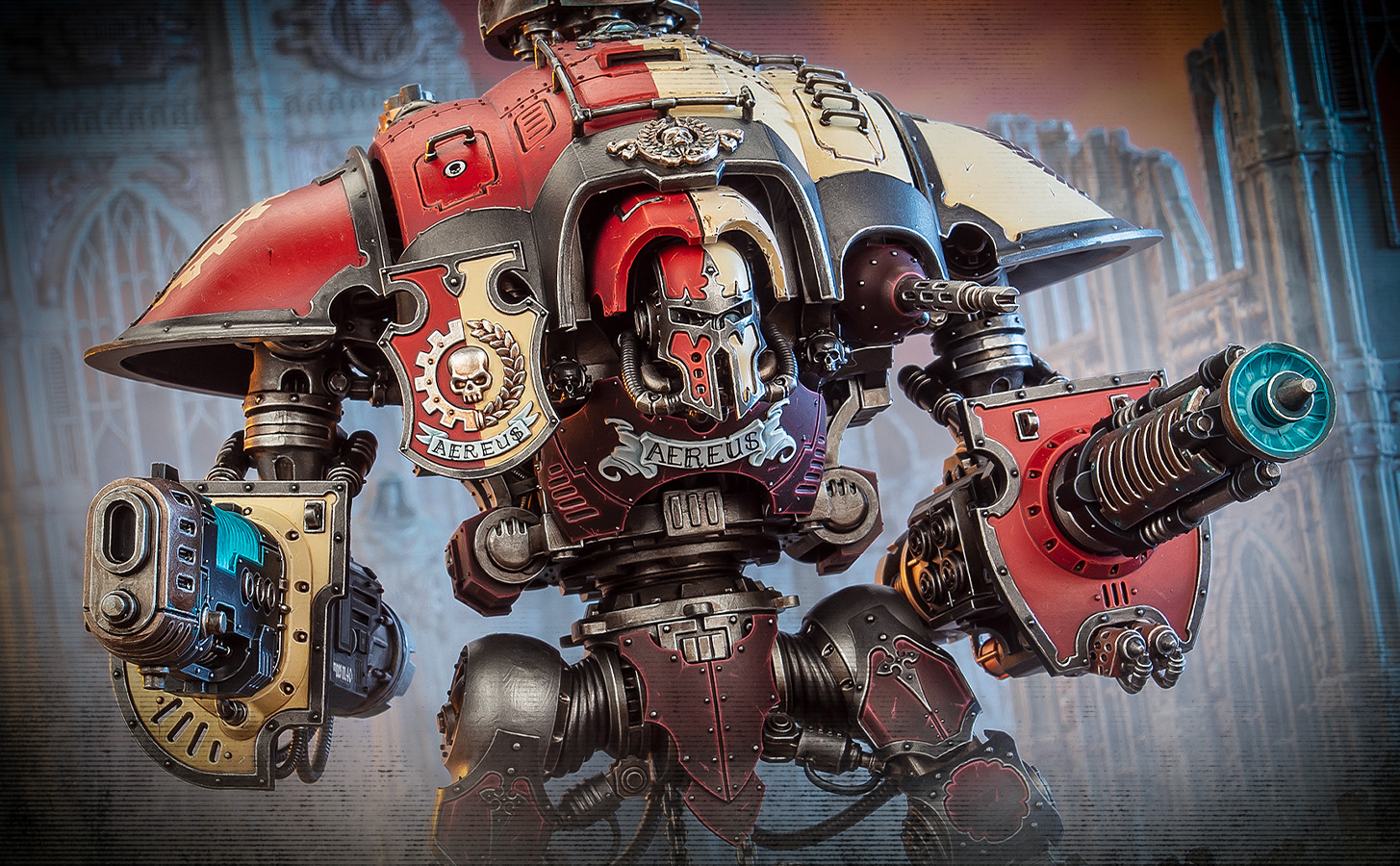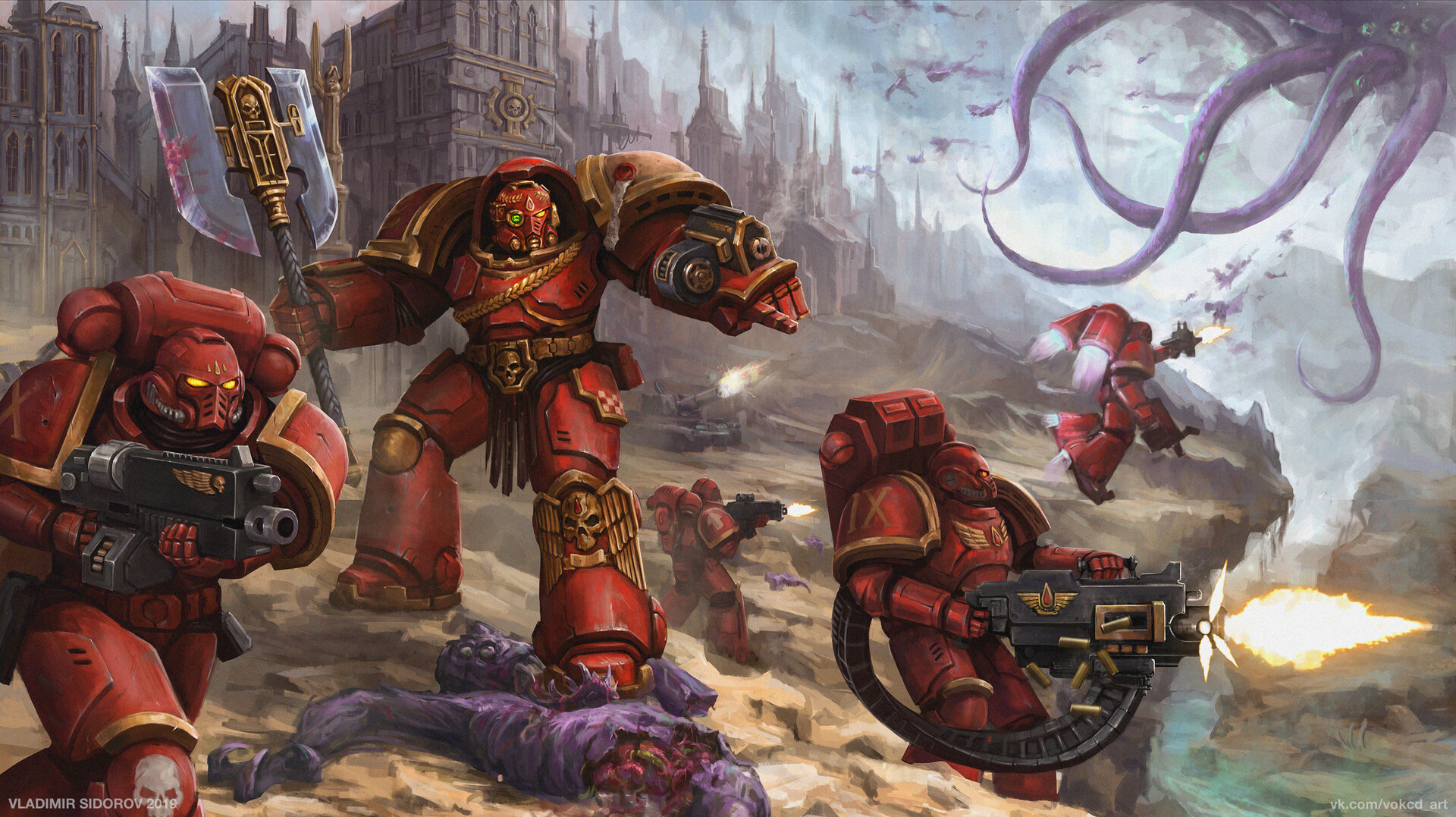Introduction
In the revered archives of the Administratum, one finds record of the IIIrd Legion – the illustrious Emperor’s Children. Once, they stood as paragons of the Imperial ideal, a Legion forged from Terra’s noble bloodlines and dedicated to the pursuit of unsullied excellence.
So exemplary were their deeds that the Emperor Himself granted them the singular honor of bearing the Palatine Aquila, His personal double-headed eagle, upon their breastplate – a distinction earned by no other Legion at that time.
It is said this honorific name, “Emperor’s Children,” was bestowed after they defended the Master of Mankind during the Proximan Conspiracy with peerless loyalty and skill. In those early days, they exemplified all that a Space Marine Legion could aspire to: pure in gene-seed, peerless in discipline, and utterly devoted to the Emperor’s vision.
Yet from such lofty heights, a fall into darkness can be all the more devastating. The Imperial scholar quills this account as both history and warning – a cautionary chronicle of how obsession and pride corrupted the Emperor’s Children.
In their noble infancy they embodied unblemished honor, pursuing perfection in all endeavors. But the rot of arrogance took root unseen, and the Legion that once carried the Emperor’s own icon would soon betray Him in the worst of ways.
This record traces their rise and harrowing descent, preserved that all who serve the Golden Throne may learn from the tragedy of Fulgrim and his damned sons. Let this account stand in the archives of Terra as a grave warning: that the brighter the flame of pride, the darker the shadow of Chaos that follows.
The Pursuit of Perfection
From the moment of their inception, the Emperor’s Children were utterly fixated on achieving absolute excellence. Primarch Fulgrim, known as “the Phoenician,” was rediscovered by the Emperor and given command of this small but elite Legion.
It is recorded that upon first addressing his mere two hundred Legionaries, Fulgrim swore that they would prove worthy of bearing the Emperor’s name. Thenceforth, a zealous drive for perfection defined every aspect of their culture and warfare.
To Fulgrim and his sons, the Emperor was the pinnacle of perfection, and they strove to mirror that ideal in themselves. Every stratagem, every blade stroke, every battle was to be a flawless work of art in the Emperor’s honor.
Indeed, their appetite for martial excellence was matched only by a blossoming passion for the finer arts of civilization – literature, sculpture, music – pursuits scarcely known on Fulgrim’s bleak homeworld of Chemos before his coming.
Under the Phoenician’s tutelage, the Legion came to believe that mastery in war was not enough; they must also achieve greatness in aesthetics, philosophy, and governance, becoming nothing less than the Emperor’s perfect warriors-scholar.
Such lofty ambition yielded many early triumphs. Imperial chronicles recount, for example, how Fulgrim once conquered the fortress-world of Byzas with only seven Astartes at his side – a dramatic feat intended to prove that sheer perfect strategy could overcome any odds.
In the Great Crusade, when the Emperor’s Children finally grew in number and marched to war beside their Primarch, they became renowned for impeccable battlefield conduct. Their battle formations were precise to the finest detail, their armor and weapons maintained in immaculate condition, often embellished with gilding and artwork emblematic of their victories.
To the other Legions, these warriors cut an almost regal figure – proud, resplendent, and utterly confident in their purpose. Fulgrim’s influence saw that no endeavor was beyond his Legion’s reach: having perfected every tactic of war, he encouraged his officers and troops to hone skills in poetry, song, and even administration, believing a truly perfect servant of the Emperor must excel in all things.
Yet with perfection came pride, and with pride came peril. The Emperor’s Children gradually grew aware of their own excellence – and in that awareness, hubris took seed.
Other Imperial forces observed a certain haughtiness in the IIIrd Legion’s demeanor. They held themselves above the “lesser” regiments of the Imperial Army they often led into battle, viewing the common troops as crude instruments to be orchestrated by Astartes genius.
In subtle ways, the Legion’s pursuit of flawlessness fostered an elitism and vanity; they would sooner blame or cast aside the imperfect than admit any failing of their own. So assured were they of their righteousness and capability that warnings went unheeded.
What began as noble pride in their Emperor-given talents swelled into a sense of invulnerability. The Imperial Truth they upheld left no room for doubt in themselves – a tragic irony, for this very blindness to fault would pave the road to damnation. As the decades of triumph wore on, the Emperor’s Children did not notice the fine line between seeking perfection and worshiping it; in their hearts, the seed of heresy quietly germinated.
The Seeds of Damnation
Every great fall from grace begins with small, malign influences, and for the Emperor’s Children those seeds were planted during the late Great Crusade. In the campaign against the alien Laer, Fulgrim demonstrated both the heights of his Legion’s dedication and the first tremors of their corruption.
The so-called Cleansing of Laeran was hard-fought – an exhibition of extreme effort and sacrifice in pursuit of victory. At its conclusion, Fulgrim claimed a magnificent prize from a xenos temple: a beautifully wrought sword later named the Silver Blade of Laer.
Unbeknownst to the Phoenician, this glittering weapon was no mere trophy – it was a Daemon Weapon, a blade tainted by a warp-entity of Slaanesh, the Dark Prince of Chaos. The Laer blade’s whispers were subtle at first, imperceptible to the Primarch’s proud mind. But from the moment his hand closed around its hilt, the rot of Chaos had found purchase in Fulgrim’s soul.
As the Great Crusade entered its final days, subtle changes in the Emperor’s Children’s behavior were noted by their peers. Fulgrim became increasingly fixated on surpassing all others, sometimes to the detriment of caution. He and his inner circle pursued ever more esoteric experiences – exotic perfumes, peculiar combat stimulants, the eerie soundscapes of xeno-music – all in the name of testing the limits of sensation and martial prowess.
What they dismissed as mere cultural affectations or rewards for victory were in fact the first tastes of excess that the Chaos Gods dangled before them. The Legion’s quest for perfection was slowly being perverted into a quest for new sensations and forbidden knowledge.
In private, Fulgrim began to entertain doubts and paranoias fueled by the insidious voice of the daemon blade. He became quicker to anger at any imperfection and drove his warriors to punish even trivial shortcomings with draconian zeal. The subtle poison of Slaanesh was working its way into the Legion’s heart, blinding them with pride and corrupting their very ideals.
It was into this moment of vulnerability that the Warmaster Horus – himself already fallen to Chaos – struck with masterful cunning. Fulgrim had long admired Horus as a brother; during the early Crusade the Luna Wolves Legion had even been mentors and comrades to the small Emperor’s Children force.
That bond of camaraderie became the avenue through which treachery entered. The precise details of Horus’s seduction of Fulgrim are lost to Imperial history, obscured by the lies of the Traitor and the passage of time. Yet scholars concur that Horus played expertly upon Fulgrim’s refined sensibilities and towering ambition.
The Warmaster flattered the Phoenician, suggesting the Emperor did not appreciate the IIIrd Legion’s glory, and that greater heights of power and personal perfection could be attained if only Fulgrim would embrace a new perspective. He whispered that the Emperor’s grand plan had gone astray, that false and petty bureaucrats in the fledgling Imperium conspired against the Primarchs.
To one so driven to achieve ultimate glory, these suggestions were as honeyed as they were poisonous. Horus promised Fulgrim and his Legion the chance to truly display their perfection – an opportunity to unleash their full potential, unfettered by the Emperor’s caution and conservative restraint.
Fulgrim wrestled with this decision – for loyalty and pride warred within him. But the dark whispers of the Laer blade and the relentless stoking of Horus eventually overcame his better angels. In a fateful moment, Fulgrim chose to side with his beloved brother Horus against the Master of Mankind.
Thus were the seeds of damnation sown in the Emperor’s Children. What began as a quest for excellence now curdled into rebellion and heresy. Dissenting voices within the Legion – those few officers and battle-brothers whose faith in the Emperor remained unshaken – were swiftly silenced.
On Isstvan III, Fulgrim proved his commitment to Horus by participating in the treacherous purge of all Loyalist elements from his ranks. Loyal Emperor’s Children such as Captain Solomon Demeter and the famed Ancient Rylanor attempted to resist the massacre, only to be outmatched by their former brethren’s overwhelming firepower.
Their noble deaths were but the first of countless atrocities to come. When Fulgrim ordered virus bombs deployed on Isstvan III to exterminate the remaining Loyalists, any last hopes of the IIIrd Legion’s redemption were turned to ash. The Emperor’s Children had forsaken honor for ambition, stepping irrevocably onto the path of Chaos.
Hedonistic Descent
With the Horus Heresy in full flame, the Emperor’s Children plunged into an abyss of hedonistic cruelty from which they would never emerge. As open war against the Imperium erupted, Fulgrim and his Legion gave themselves over to bloodlust and excess on a scale unimaginable.
Their downward spiral accelerated at the infamous Dropsite Massacre of Isstvan V, where Fulgrim confronted his once-beloved brother Ferrus Manus, Primarch of the Iron Hands. In a confrontation that has become legend for its tragic brutality, Fulgrim attempted one last time to sway Ferrus to Horus’s cause.
But the Iron Hands Primarch would not yield to treachery. Betrayed and enraged, Ferrus met Fulgrim in a duel of demigods amidst the slaughter. Blade met hammer – Fireblade clashing against Forgebreaker – in a contest of strength and skill between two masters.
In the end, Fulgrim struck Ferrus Manus down, taking the life of the staunchest of the Emperor’s loyal sons. It is written that in the instant of Ferrus’s death, Fulgrim’s sanity wavered. Gazing upon the decapitated body of his brother, the Phoenician realized the monstrosity of his deed and was momentarily aghast at the depths to which he had sunk.
But in that moment of horrified clarity, the Chaos corruption within him surged forth. The daemon bound within the Laeran blade seized control of Fulgrim’s shattered soul – a final surrender to damnation that sealed both Primarch and Legion to the service of Slaanesh forever.
After Isstvan V, any remaining semblance of restraint or nobility in the Emperor’s Children was utterly annihilated. Having passed the ultimate moral event horizon by murdering a brother Primarch, Fulgrim abandoned himself to sensation and sin.
He became the very champion of excess he once would have loathed. The Legion, following their gene-sire’s example, likewise descended into depravity unbound. No atrocity was too great, no debauchery too extreme, so long as it fed their insatiable quest for new experiences and pleasures.
They hacked apart the populations of entire worlds in orgiastic frenzies of slaughter, reveling in screams and bloodshed as though it were music and wine. On the war-torn forge world of Prismata, for instance, Emperor’s Children squads were reported to fall upon manufactorum workers in grotesque “celebrations” – flaying, torturing, and even crafting art from the bodies of the innocent, all as a twisted offering to the Dark Prince. This Legion that once prided itself on martial elegance now took pride only in the artistry of cruelty.
As the Heresy raged toward its apocalyptic climax on Terra, the Emperor’s Children fully embraced the patronage of Slaanesh, the Chaos God of excess and perversion. They became the foremost instruments of horrific excess among Horus’s forces.
While other Traitor Legions still fought with some semblance of military purpose at the Siege of Terra, the Emperor’s Children gave in completely to their vile desires. During the final battle on Holy Terra, Fulgrim’s warriors were notably absent from the fiercest assaults on the Imperial Palace walls.
The likes of the World Eaters and Death Guard battered themselves against the defenses, but the Emperor’s Children took a different path. They spilled into the helpless civilian sectors beyond the Palace, transforming the siege into a playground for their obscene appetites.
It is recorded that they laid waste to the outer districts of the Throneworld in an orgy of unfettered cruelty, slaughtering untold thousands – perhaps millions – of the Emperor’s subjects with wanton glee. Where the IIIrd Legion passed, terror reigned: the air itself throbbing with discordant music from their sonic weaponry and the tortured screams of prisoners.
In these dark days, the first of the cacophonic Noise Marines emerged – Astartes whose senses and weaponry had been mutated by warp-taint into lethal instruments of sound. The cacophony of warp-amplified shrieks and subsonic blasts they unleashed could turn human brains to jelly and crumble city blocks. To the Emperor’s Children, this was the perfect weapon – war as an art form, death as a symphony.
Slaanesh’s hold on the Legion was formalized in these final stages of the Heresy. In dark rituals on the fields of Terra’s devastation, the Emperor’s Children offered up heaps of mutilated flesh, exotic drugs, and stolen relics in exchange for the Prince of Pleasure’s blessings.
Their reward was corruption made manifest. Mutations ran rampant through their ranks: elegantly twisted horns, extra limbs grown to better inflict pain, skin that constantly flickered with iridescent hues.
Fulgrim himself achieved the ultimate “blessing” of Chaos. Having given himself completely to Slaanesh, Fulgrim was granted Apotheosis – ascension to the immortal rank of a Daemon Prince. The Primarch’s physical form transfigured into a serpentine abomination of terrifying beauty, said to possess four arms, a scaled tail and great draconic wings – a shape eerily reminiscent of the Laer daemon that had first seduced him.
In this new form, Fulgrim was nigh-unstoppable, a being of hate and dark ecstasy who would plague the Imperium for millennia to come. The Emperor’s Children ended the Heresy as utterly lost souls, servants not of honor or Imperium, but of depravity made divine. The once-noble IIIrd Legion had become the favored playthings of Slaanesh – their noble eagle standard now a corrupted icon dripping with the blood of innocence.
The Emperor’s Children in the Age of Chaos
In the aftermath of Horus’s defeat and the shattering of his rebellion, the Emperor’s Children survived – but in a form greatly diminished and unrecognizable from their proud origins.
The Loyalist victors of the Horus Heresy launched the Great Scouring, driving the Traitor Legions from Terra and pursuing them in vengeance across the stars. Fulgrim and his Emperor’s Children, now outcasts and Excommunicate Traitoris, fled toward the eye of the Warp from whence their new foul powers came.
On their path of retreat they left a trail of depopulated worlds, ravaging any territory they passed out of spite and sadism . Imperial records grimly note that entire planetary populations were enslaved or slaughtered to slake the IIIrd Legion’s thirst for carnage as they fled to sanctuary in the Eye of Terror. If the Heresy had ended in defeat, the Emperor’s Children were determined to savor every last drop of cruelty they could extract on their way into exile.
Within the Eye of Terror, that roiling daemon-infested region of Warp-space, the Traitor Legions licked their wounds and began to rebuild. For the Emperor’s Children, however, rebuilding quickly turned to infighting and madness.
Without Horus’s leadership and with Fulgrim increasingly aloof (lost in his own insane pursuit of perfect damnation), the Legion’s unity disintegrated. The Emperor’s Children had always been driven by individual pride and sensation, and now those very traits splintered them apart.
Their supply of slaves and victims ran low as the initial conquests in the Eye were expended by their endless orgies of torture. In their desperation for new toys and fresh experiences, the Emperor’s Children warbands even turned on the other Traitor Legions.
They raided their fellow renegades for genetic materials, arcane stimulants, and slaves, betraying any not quick enough to defend their resources. This sparked a period of vicious internal conflict among the Traitors known as the Legion Wars or Slave Wars.
The once mighty armies of Chaos that had nearly toppled the Imperium fell upon one another like a pack of rabid wolves. In these wars, the Emperor’s Children earned the enmity of all – their former allies united to punish them for their excesses.
The Sons of Horus (Horus’s own legion) in particular were outraged when Fabius Bile, the Emperor’s Children’s Chief Apothecary-turned-mad scientist, defiled the Warmaster’s corpse in a blasphemous attempt to clone Horus himself.
That act of sacrilege – an effort by Bile to create a new Horus and perhaps regain a measure of control over the Chaos forces – backfired spectacularly. The clone was destroyed and Ezekyle Abaddon, Horus’s vengeful protégé, retaliated by mustering a united assault against the Emperor’s Children’s strongholds.
The climax of the Legion Wars came with the siege of Harmony, a daemon-world turned into Fulgrim’s pleasure-palace and de facto throneworld of the Emperor’s Children. Abaddon’s forces, including elements of every major Traitor Legion, descended upon Harmony with unforgiving wrath.
In a stroke of unforgiving genius, the vengeful Warmaster-ascendant turned the Emperor’s Children’s decadence against them – hurling a captured eight-megaton starship directly onto the planet’s capital, Canticle City. The colossal impact shattered the city in an instant, killing countless Emperor’s Children and sundering their primary fortress.
In the aftermath, Abaddon’s troops swarmed the ruins, cutting down Fulgrim’s chosen warriors and scattering the survivors to the Warp-winds. By the time the Legion Wars burned out, the Emperor’s Children were shattered as a Legion. No longer did they exist as a coherent fighting force; their unity was irretrievably broken. What remained were ragged, competing warbands, each led by its own Champion or depraved lord, roaming the Eye of Terror in search of their next excess.
This fracturing proved a bleak mercy for the Imperium – for a fully unified Emperor’s Children Legion under a Daemon Primarch would have been a nightmare of unprecedented scale. Instead, in the ten thousand standard years since the Heresy (now known as the Age of Chaos or the Long War), the Emperor’s Children have been encountered only in these scattered warbands.
They are fewer in number than most other Traitor legions, owing to the devastating losses inflicted on them by the Loyalists and in their own internal wars. However, to assume them a minor threat would be a grave mistake. Each Emperor’s Children warband that lurks in the shadows of the galaxy is a self-contained carnival of horror, capable of atrocities that make even veteran Inquisitors blanch. They frequently augment their strength by capturing new slaves and even tempting renegades from other forces to join their pursuit of pleasure.
When they strike out from the Eye in raids, their objectives are not worlds to conquer but victims to claim. Their love of taking prisoners for unspeakable tortures is well-documented; indeed, many Inquisitors believe there is no worse fate than to fall into the hands of the Emperor’s Children, save perhaps being taken by the xenos sadists of the Dark Eldar.
Those unlucky enough to be caught alive by these Slaaneshi Astartes are subjected to agonies beyond imagination – kept at the knife’s edge between life and death as playthings in perverse experiments of sensation. Over the millennia, entire Choirs of Pain (as some warbands style themselves) have perfected the art of sustaining captives in torment for months, even years, to prolong their sickening revels. The echoes of those screams resound through the Warp, feeding Slaanesh’s power and bolstering the Legion’s reputation as the most depraved of the Traitors.
And what of Fulgrim, the Primarch of the Emperor’s Children, in this Age of Chaos? Imperial scholars have long pondered the fate of the Phoenician after the Heresy. It appears that Fulgrim disappeared from the galaxy for many centuries, turning his back even on his own Legion. Having ascended to daemonhood, the Primarch grew bored with the “pedestrian” excesses of his mortal followers and retreated to a hidden Daemon World deep in the Warp.
There, on a planet he named “Callax” after the capital of his lost home Chemos, Fulgrim constructed a twisted paradise of his own. He reshaped that world’s reality to mirror Chemos and endlessly recreates the battles of his past, apparently trying new strategies each time in a mad search for the perfect outcome that history denied him.
Ensconced in this nightmare realm of his own making, Fulgrim indulges in unimaginable extremes of sensation and cruelty, far from the reach of any Imperial vengeance. Only rarely does he deign to involve himself in the affairs of realspace or even of his scattered children.
The Emperor’s Children warbands themselves often quest after this hidden world, some seeking guidance or favor from their dark primarch, others hoping to usurp his power. Few ever find Callax, unless Fulgrim wills it. Not even the Ordo Malleus has pinpointed its location, despite exhaustive searches. On those rare occasions Fulgrim has visitors, it is said he welcomes them with grand courtesy – before subjecting them to such mind-shattering experiences that even most devout Slaanesh cultists would quail.
Though withdrawn, Fulgrim has not been entirely idle over the millennia. From the shadows, he has occasionally bargained or allied with fellow agents of Chaos for mutual benefit. Notably, the arch-warlord Abaddon the Despoiler managed to treat with Fulgrim on the eve of launching his Black Crusades.
In one instance, Abaddon secured Slaanesh’s favor by offering Fulgrim an unsullied psychic soul – a potent human psyker taken during the Pandorax Campaign – as a “gift” to the Daemon Primarch. Such was the price to buy the support of the Dark Prince’s champion. Fulgrim accepted this offering, and in return tolerated Abaddon’s use of Emperor’s Children contingents in the Black Crusades, even lending the strength of his Dark God to those endeavors.
Thus, the Emperor’s Children survived into the 41st Millennium: fractured, few, but still steeped in unimaginable corruption and poised to unleash hell wherever the whim took them.
Modern Atrocities and the Long War
In the current age – the late 41st Millennium and dawn of the 42nd – the Emperor’s Children and their offshoot warbands remain active protagonists of the so-called Long War. This Long War is the traitors’ eternal campaign of vengeance against the Imperium that cast them out.
For the Emperor’s Children, however, it is not merely about vengeance; it is equally about indulging in carnage for its own sake. Over ten thousand years, they have perfected the art of warfare as depraved entertainment. Their assaults are often less about strategic gain and more about creating the maximum sensory impact – to experience every shred of agony, terror, and ecstasy that battle can provide.
When they raid into realspace from their hellish abodes, it is as if a demonic symphony comes forth. Loyalist forces have reported that confronting these Chaos Marines in battle is an assault on senses and sanity alike: strobes of psychedelic light from corrupted wargear, the keening wail of sonic weapons, the laughter of maniacs echoing through vox channels. They turn war into a theater of living nightmares.
Despite their fractured nature, Emperor’s Children warbands have taken part in some of the most terrible incursions of recent centuries. Many have sworn allegiance to Abaddon during his Black Crusades, lending their expertise in terror tactics and noise weaponry to the Warmaster’s armies. Others launch independent campaigns, great and small, wherever a gap in Imperial vigilance appears.
Among their most infamous atrocities in modern times is the Cacophony of Extremis Six. In ca. 999.M41, during Abaddon’s 13th Black Crusade, a host of Emperor’s Children under the command of the notorious Champion Lucius the Eternal assaulted the densely populated Imperial world of Extremis VI.
Alongside a corrupted Titan Legio known as the Riotous Host, they enacted a nightmare plan. At Lucius’s order, the traitor Titans and Noise Marines synchronized their sonic weapons and unleashed waves of destructive resonance across the planet’s massive city-spires.
The starscraper hab-blocks of Extremis VI shuddered and collapsed under the onslaught of sound, the very buildings torn apart by hellish vibration. In mere hours, the populace of an entire world was reduced to screaming ruin – billions perished in that orgiastic cacophony.
By the time Imperial response forces arrived, the air itself was thick with a haze of agony and Warp-spawned discord. Though elite Astra Militarum regiments and Tempestus Scions deployed valiantly to counterattack, they found themselves facing not merely traitor marines, but the flesh-and-blood manifestation of Fulgrim’s malice.
A giant, serpent-bodied Daemon cut through the Imperial ranks, impervious to small-arms fire, crushing tanks and swatting aside soldiers like insects. Imperial analysts later concluded what the surviving troopers only realized in their final moments – this monstrous being was likely Fulgrim himself, returned to realspace to revel in the slaughter of Extremis VI.
By the operation’s end, the world of Extremis was left a ghastly, silent tomb. The Emperor’s Children had already withdrawn, no doubt sated – for a time – by the excesses they had committed there.
That is but one example. Time and again, these degenerate hedonists have struck at the Imperium without warning. Worlds that have known peace for centuries suddenly find themselves in the crosshairs of a foe who does not seek conquest or plunder in the traditional sense.
Instead, the Emperor’s Children seek scenes fit for their depraved sensibilities – a shrine world’s holy choir silenced and turned into a chorus of screams, a knightly house’s nobles corrupted into gibbering pleasure-slaves, an entire PDF garrison forced to butcher each other for the amusement of their captors.
No objective is too perverse or absurd if it brings new extremes of sensation. In one recorded incursion, a warband calling itself the Symphony of Pain infiltrated the agri-world Choeridia and poisoned the planet’s water supply with a toxin that heightened nerve sensitivity a thousandfold.
When they launched their open assault, the defenders died in droves not only from bolter and blade, but from the sheer overwhelming pain of hearing the warband’s amplified war songs, which ruptured organs and induced lethal seizures. The few survivors were dragged away to serve as living instruments – their vocal cords and bones crafted into bizarre noise devices for the next battle.
Meanwhile, the Daemon Primarch Fulgrim continues to cast his long shadow over the Imperium’s fate. Though he rarely emerges from the Immaterium, when he does, it is catastrophic.
With Horus long dead and most other Traitor Primarchs either vanished or unhinged, Fulgrim stands as one of the foremost champions of Chaos in the current age. When the blessed Primarch Roboute Guilliman was resurrected in the closing days of M41, walking the mortal plane once more, Fulgrim was quick to make his presence felt.
As Guilliman assembled the Imperium’s hosts on Macragge, Fulgrim possessed the body of a high Imperial dignitary to appear at Guilliman’s triumph, delivering a taunting message. Through the mouth of this unwilling host, Fulgrim congratulated his brother’s return with venomous irony – and warned him that even a son of the Emperor reborn would face endless temptation and damnation of the soul. This chilling encounter underscored the spiritual threat that Fulgrim and his patron Slaanesh pose even to the mightiest of the Imperium’s heroes.
Not long after, in the Era Indomitus, Fulgrim personally led a host of Emperor’s Children against elements of the Iron Hands Chapter (descendants of Ferrus Manus) in what Imperial strategists believe was a deliberate act of malice and mockery. On the world of Sabbyst, Iron Hands forces seeking vengeance for their ancient Primarch’s murder were lured into battle with Fulgrim himself.
The confrontation ended in disaster for the Iron Hands – their forces shattered, their champions slain one by one by the laughing Daemon Prince, who reportedly toyed with his prey in elaborate duels before delivering the killing blows.
Such incidents remind the Imperium that Fulgrim’s unholy wrath remains a clear and present danger. Though ten millennia have passed, the Phoenician has not tired of tormenting the sons of his hated father. Each time he returns, it is as if the Heresy lives again – a bitter echo of brother fighting brother, drawn out to an eternity of suffering.
And so the Emperor’s Children persist into the modern era: a broken Legion, yes, but one that plays a discordant melody of despair across the stars. In their pursuit of the Long War, they have no interest in the politics or dominion sought by other Chaos forces.
Instead, they wage war as performance, as worship of Slaanesh and as an expression of their eternal spite for what they once were. Every attack is an act of blasphemy and self-indulgence – a continuation of the grand atrocity that Fulgrim and his generals began during the Horus Heresy.
The Imperium can never afford to underestimate these degenerate traitors. A single Emperor’s Children warband loose in a sector can within weeks spark a tragedy to rival the worst xenos predator or Chaos incursion.
Worse still, whispers in the Warp suggest that Fulgrim has begun to take a greater interest in the mortal realm once more; prophecy and intercepted cult messages hint that the Daemon Primarch plans a grand symphony of devastation to usher in the coming millennium.
If ever the disparate warbands of the Emperor’s Children were to reunite under Fulgrim’s banner for a renewed offensive, the scale of depravity and destruction unleashed would dwarf even the horrors of the Horus Heresy.
Conclusion
The lamentable saga of the Emperor’s Children stands as a stark morality tale inscribed in blood across the pages of Imperial history. Here was a Legion born of the Emperor’s genius and faith – gifted, honored, and trusted above so many others – yet they fell farther than any, seduced by the very pursuit of perfection that once defined them.
In them we see how the noblest aspirations can be twisted into vice by the insidious whisper of Chaos. Fulgrim and his sons sought to become perfect, to elevate themselves to stand equal with the Emperor’s glory, but in so doing they harbored pride and vanity.
Chaos seized upon that flaw, however small, and festered within, until the proud Legion of the Palatine Aquila became a horde of narcissistic killers in thrall to a Dark God. No reward of Chaos is ever what it seems – the Emperor’s Children won for themselves only eternal damnation, their bright colors and beautiful wargear forever smeared with the filth of unspeakable acts.
Let the fate of the Emperor’s Children serve as a warning to all servants of the Imperium: Heresy often blooms from hubris. The corruption of Chaos wears many faces – it may appeal to one’s vanity, one’s ambition, even one’s virtues twisted into new forms.
The Lord of Excess in particular is adept at turning pride into indulgence, and indulgence into damnation. The story of the IIIrd Legion teaches that no one – not even a Primarch or the most acclaimed heroes of the Imperium – is beyond the corrupting touch of Chaos, save by unwavering vigilance and humility.
Had Fulgrim tempered his pride with loyalty, had his warriors checked their arrogance, perhaps this tragedy could have been averted. Instead, their name is now a curse upon the lips of billions, and their once-hallowed honor banner lies trampled in the blood of innocents.
Even now, ten thousand years later, the Emperor’s Children remain a thorn in humanity’s side – a remnant of Horus’s sin that continues to weep pus and venom into the galaxy. Though broken into shards, they are no less malevolent.
Each warband, each champion that bears the sign of the Kakophoni or the sigil of the clawed eagle, is a walking reminder of the Heresy’s lingering scourge. They lurk in the shadows of the Eye of Terror and beyond, waiting for the chance to inflict pain and depravity upon a humanity they once swore to protect.
The Ordo Malleus monitors their movements closely, and the Adeptus Astartes know well to be on guard for the telltale signs of Slaanesh’s servants: the eerie, musical dissonance that precedes an Emperor’s Children assault. For where they tread, madness and corruption follow swiftly.
In the end, the tale of the Emperor’s Children is a tragedy – but one from which the Imperium must glean wisdom. Perfection belongs only to the God-Emperor. Any man or transhuman who believes himself flawless courts the same fall as Fulgrim.
Thus we seal this account in the archives with a final exhortation: Heed well the lesson of the Third Legion. Their noble purity was a façade that hid growing rot, and by the time the mask fell, it was too late. We must purge pride with penitence, ambition with duty, and temptation with faith.
Only by remembering the fall of the Emperor’s Children can we ensure that no others follow in their footsteps. For as long as they persist – broken, but not entirely beaten – the Imperium must remain ever vigilant. The Long War has not ended, and the Emperor’s Children still revel in their unholy symphony of war and wickedness, awaiting the damned encore that will finally drown the stars in screams and silence.
Thus ends this chronicle, compiled in the sixteenth year of the 41st Millennium, by the hand of Archivist-Lexicanius Kalar, Adeptus Administratum, under the auspices of the Ordo Malleus. May the Emperor’s Light illumine all readers of these words, that they do not falter as Fulgrim did.
